Ontario is an incredible province of Canada, with intriguing geography, rich history, and beautiful flora and fauna. The province is home to a large portion of the population of the country. It features a diverse climate and land type and is home to a huge number of lakes and forests. Ontario is a rich cultural hub, with a long history dating back to mammoths and mastodons!
Learn about Ontario’s geography, history, wildlife, culture, and more by checking out this list of 100+ fun facts. You’ll certainly know a lot more about the province than you did before you read it! Read on and learn something new. Take some time to browse this list. Whether you’re native to Canada or just looking to succeed at trivia night, these fun facts are sure to delight and inspire.
Geography
Size
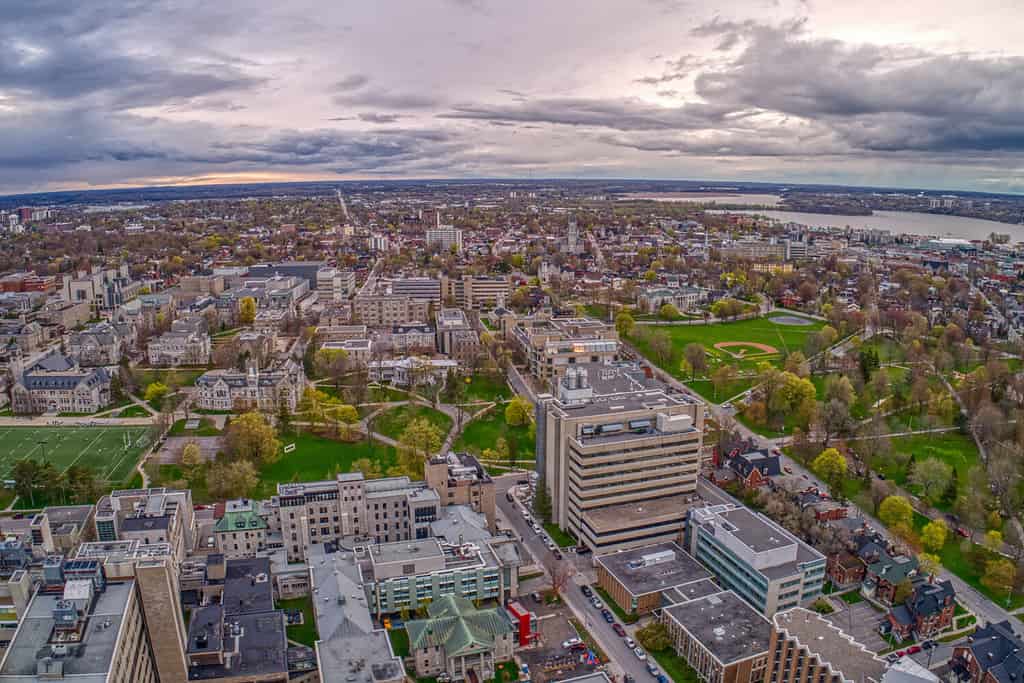
1. Ontario is home to 14.57 million residents. The three largest cities in Ontario are Toronto, Ottawa, and Hamilton.
©Jacob Boomsma/Shutterstock.com
2. The province is 416,600 square miles (more than 1 million square kilometers).
3. Ontario is home to the world’s largest freshwater island, which is Manitoulin Island. This island is over 1,000 square miles in size.
4. There are two time zones within the boundaries of the province: Central Time Zone and Eastern Time Zone.
5. The Great Lakes that neighbor Ontario contains 1/5 of the world’s fresh surface water.
6. Almost all residents of Ontario live between the Great Lakes and St. Lawrence River Basin (98%!).
7. 66% of Ontario’s land is made up of forests. In fact, the forests of this province constitute over 15% of the forests in all of Canada.
8. The provincial parks of Ontario make up over 9 million hectares of land, which is over 22 billion acres.
9. Ontario is the second largest province of Canada by land area. Indeed, the first largest province is Québec.
10. Over 60% of the province is covered by the Canadian Shield, which is one of the world’s largest continental shields.
11. Ontario is home to 1/3 of all residents of Canada, and it was admitted in 1867.
12. Six national parks and 334 provincial parks exist within Ontario. There are 38 national parks in all of Canada.

13. Most of the drinking water in the province comes from the Great Lakes.
©iStock.com/PeterHermesFurian
Geographical Make-up
14. The highest point of elevation in Ontario is 2,274 feet above sea level. That is the Ishpatina Ridge. The highest point of elevation in Canada, however, is Mount Logan, which reaches 19,551 feet in elevation.
15. Ontario is the #1 metal producer in Canada. In fact, the province produces a significant portion of nickel, copper, platinum, and gold.
16. This province of Canada borders four out of five of the Great Lakes: Huron, Ontario, Erie, and Superior. Indeed, the province does not make contact with Lake Michigan.
17. Ontario is home to three climate types: subarctic, warm-summer humid continental, and hot-summer humid continental. However, the majority of the province is subarctic.
18. The most common type of severe weather in Ontario is thunderstorms. However, the province now averages more than 15 tornado touchdowns a year, and that number is increasing.
19. Ontario is home to over 250,000 lakes.
20. Northern Ontario and Southern Ontario are the two prominent regions of the province. They have very different characteristics.
21. Canada is home to seven physiographic regions. Three of these take place in Ontario: Hudson Bay Lowlands, the Canadian Shield, and the St. Lawrence Lowlands.
22. Historically, Ontario was covered in ice. However, the recession of the ice is what created so many of the lakes currently present in the province today.
23. Ontario is home to a “Snow Belt” that receives significant snowfall each year. The “Snow Belt” receives almost 100 inches of snow annually.
24. The Canadian Shield, which is the majority of the land of the province, cannot support very much agriculture. Markedly, the soil type is not equipped to grow crops.
25. Most of the population of the province lives in Southern Ontario. However, only 15% of the land area in Ontario is Southern Ontario.
26. Agriculture in the province is concentrated in the southern regions of the province due to moderating climates and soil quality.
History & Economy
Early History

27. Before Europeans arrived in North America, Aboriginals lived in the area that is now Ontario. Evidence of human residence dates back over 12,000 years.
©Mary Shelsby/Shutterstock.com
28. The name “Ontario” came from the Iroquois. The translation is debated, but relates to beautiful water or beautiful lake. This makes sense, given the number of lakes occupying the land!
29. Ontario and Quebec did not become separate provinces until 1867. Prior to then, they made up Upper Canada (Ontario) and Lower Canada (Quebec).
30. The primary inhabitants of the land prior to the arrival of French and British colonizers were the Algonquian and Iroquoian tribes.
31. There are 207 reserves in the province that recognize 127 of the 128 First Nations of Ontario. At this time, 44% of Indians living in Ontario live on one of these reserves.
32. Residents of British North America, which included Upper Canada (what Ontario was called at the time) were very active in the War of 1812.
33. Étienne Brûlé, a French explorer, was the first known colonizer to reach the Ontario region.
34. In 1841, Upper Canada (Ontario region) became known as Canada West.
35. 1867 was the year Ontario became its own province. Additionally, Toronto was officially designated the capital of Ontario this year.
20th Century History
36. Ontario led an energy revolution when Niagara Falls started to produce hydroelectric power in 1882.
37. Residents of the province was incredibly involved in World War I. 68,000 servicemen from Ontario were died or injured during this war.
38. The Great Depression had a big impact on the vibrant economic industries of Ontario.
39. The mining industry was the only industry that wasn’t terribly affected by the presence of the Great Depression.
40. A World War II spy school was located in Ontario, called Camp X. Supposedly, both Ian Flemming (the creator of James Bond) and Roald Dahl (the writer of Charlie and the Chocolate Factory) attended this school.
Toronto History

41. The first city in the province was Toronto, which is the capital of the province today.
©Spiroview Inc/Shutterstock.com
42. Toronto was referred to as “The Town of York” from 1793-1834, when Ontario was really Upper Canada.
43. Toronto took back its aboriginal name, Toronto, in 1834 due to the bad connotations of its previous names.
44. The population of Toronto grew enormously between 1850 and 1900. In 1851, the population was only 30,000. In 1891, the population reached 181,000! Presently, the population of Toronto is almost 3 million.
45. The Great Irish Famine moved a large number of Irish immigrants to the capital city.
46. The Great Toronto Fire of 1904 is a historic event that occurred in Toronto, burning down a large portion of the city.
Other History

As of 2019, over 60,000 students attended the historic University of Toronto.
©Jon Bilous/Shutterstock.com
47. There are 23 public universities in Ontario, the first of which was the University of Toronto. It was established in 1827. When it was founded, it was called King’s College. In 1850, it received the name it presently has today.
48. Because of the diversity of Ontario’s background, there are over 100 languages spoken within the province. In fact, almost half of the residents of the province have a primary language that is neither English nor French.
49. The official motto of Ontario is “Loyal she began, loyal she remains.” This became the motto of the province in 1909.
50. In 1848, the Niagara Falls halted for 30 hours due to ice buildup in Lake Erie!
Economy
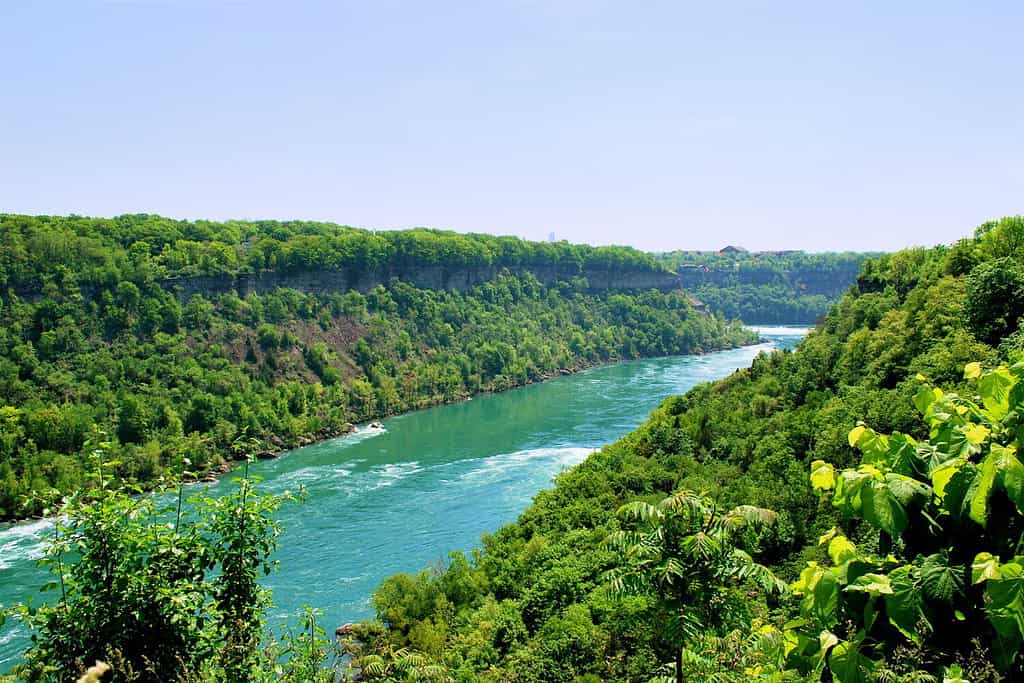
In 2020, forestry contributed over $4 billion to the GDP of Ontario.
©Sarah Meagan/Shutterstock.com
51. The economy of Ontario is the best in the country of Canada. In fact, the GDP of the province is double that of the second-place province, Québec.
52. Ontario produces 37% of the GDP of the entire country of Canada.
53. Ontario has a massive automotive manufacturing industry. Accordingly, 88% of the vehicles produced in the province are exported.
54. Half of the Class 1 farmland in Canada is in Ontario, and combined, they make up 50% of the agricultural revenue in Canada.
55. The forestry sector is another important industry in the province. Significantly, 200,000 people work directly and indirectly related to the forestry industry.
56. In 2022, Ontario produced $13.5 billion worth of minerals, which is 22% of the whole of Canada’s mineral production.
57. The largest industry in Ontario is the service sector. Indeed, 79% of the people in the province are engaged in a service business, which includes business, finance, art, and more.
Plants & Wildlife
58. Evidence of mammoths and mastodons in the area now known to be Ontario has existed since 10,000 B.C.
59. More than 3,600 species of plants and 750 types of animals thrive in Ontario. The diverse climate means that many types of flora and fauna can find their home.
Plants
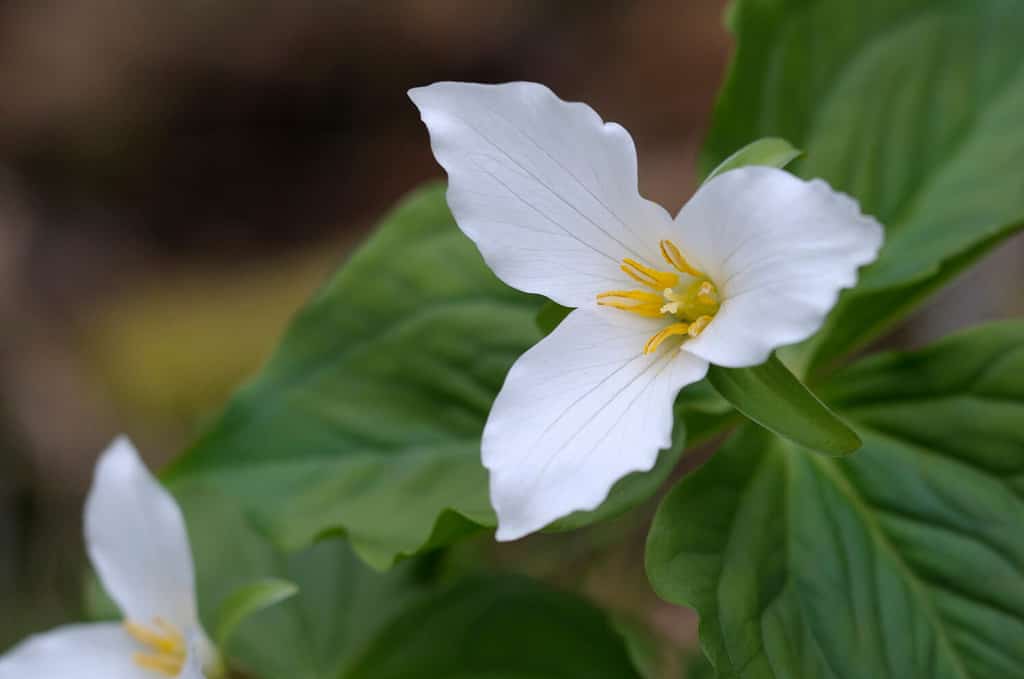
White trilliums are not illegal to pick, but they do take awhile to grow back. If you’re picking trilliums, be conscious of the environmental impact.
©Danita Delimont/Shutterstock.com
60. The official flower of Ontario is the white trillium, which was designated as the province’s floral emblem in 1937.
61. The provincial tree of Ontario is the eastern white pine, which was adopted as the symbol in 1984. Likewise, these pines are common in Ontario and can live for centuries.
62. After World War One, there was pressure to select a provincial flower because members of the service wanted to know what to plant over the graves of Canadian servicemen who passed away overseas.
63. Some of the most common plants grown in Canada include the common buckthorn, garlic mustard, common milkweed, and golden pothos.
64. Two of the biggest crops in Ontario are soybeans and corn. Indeed, Ontario grew half of the nation’s soybeans in 2021.
65. A few fruit trees grow well in Ontario, including pear, plum, peaches, and apple trees.
66. Ontario grows a significant amount of apples annually. In fact, there are over 15,000 acres of land designated to growing apple trees in this province.
67. The most common tree in Ontario is the black spruce, followed by the poplar and jack pine.
68. The oldest tree in the province is a cedar that is over 1330 years old.
Animals
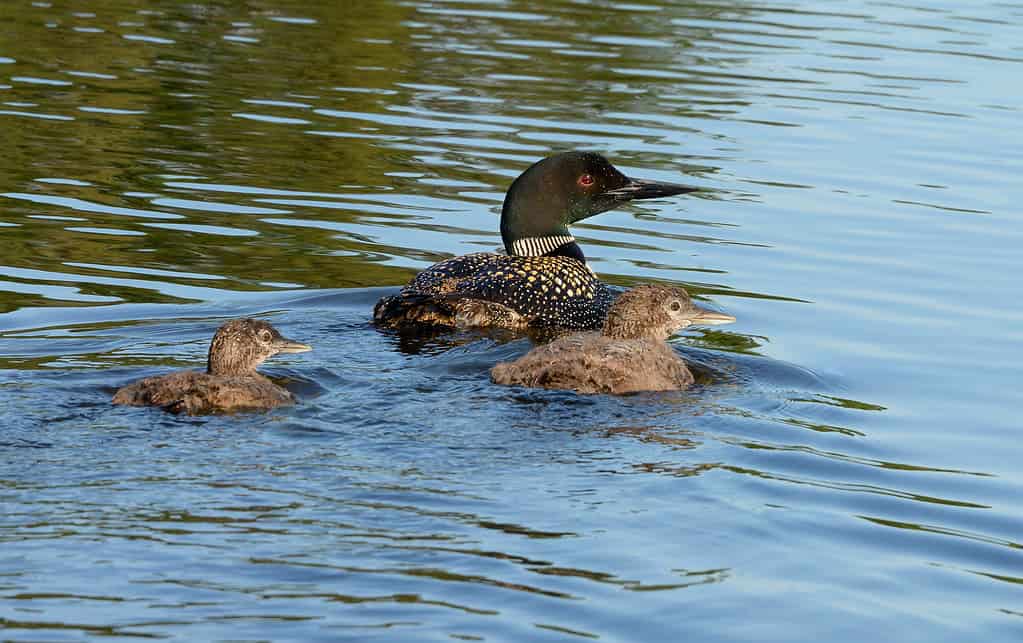
Common loons can weigh up to 18 pounds!
©Tammi Mild/iStock via Getty Images
69. The provincial bird of Ontario is the common loon, which was designated in 1994. Accordingly, a swimming loon is featured on the one-dollar coin.
70. Ontario is home to moose, black bears, wolves, otters, and beavers.
71. The largest carnivore in Ontario is the polar bear, which lives in northern Ontario.
72. Lakes in Ontario are home to a broad number of fish, including walleye, northern pike, yellow perch, and brook trout. Likewise, walleye is the most popular.
73. The most common type of deer in Ontario is white-tailed deer. However, the province is home to four types of deer species.
74. It’s estimated that there are 400,000 deer in just the province of Ontario.
75. The largest bird of prey in Ontario is the golden eagle. These raptors have a wingspan of between 6 and 7.5 feet!
Culture & Landmarks
Culture
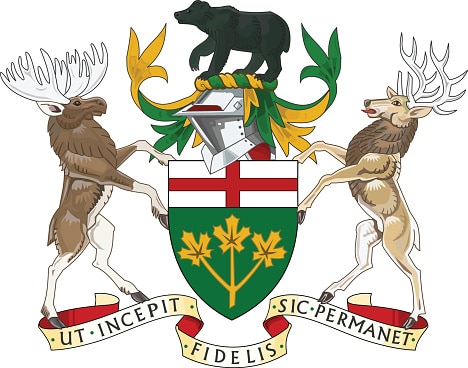
The province first adopted its coat of arms in 1868. It was altered a few decades later in 1909.
©Vektori Cetiri/iStock via Getty Images
76. The most multicultural population in all of Canada lives within the province of Ontario. In fact, over 50% of all immigrants to Canada move to the province.
77. 25% of residents in the province are immigrants.
78. An important part of Canadian and Ontarian culture is respect for the Indigenous people who lived and continue to live on the land of Canada.
79. Canadian Thanksgiving came before American Thanksgiving! The tradition dates back to 1578, whereas American Thanksgiving began in 1621.
80. Toronto is home to a long list of multicultural neighborhoods, including Chinatown and Greek Town.
81. There are more museums and art galleries in the province of Ontario than in any other province in the country.
82. The largest classical repertory theatre company is the Stratford Festival, which is located in Stratford, Ontario.
Landmarks

Each year, visitors come to see the Falls in large numbers. In fact, over 20 million tourists check out the waterfall annually!
©Jam Norasett/Shutterstock.com
83. The park that Niagara Falls is situated within is over 400 acres in size, with a third of that underwater.
84. The CN Tower, located in Toronto, was the tallest tower in the world until 2007. You can head to the top of the structure and grab a bite to eat at the restaurant. The restaurant rotates, so you’ll be able to see views of all sides of Toronto!
85. Canada’s federal government is located in Ottawa, Ontario. It’s called Parliament Hill, and the present building was built in 1859 after a fire burnt down the original building in 1849.
86. Casa Loma is a castle located in Toronto, Canada. It’s one of the only castles in North America and has been the set of many well-known films, including X-Men (2000), Chicago (2002), and Billy Madison (1995).
87. The Canadian War Museum is a large historic museum located in Ottawa, Ontario. Visitors can walk through exhibits and interactive displays to learn about the nation’s rich military background.
88. The Grotto is an amazing site located in the province of Ontario. It is within Bruce Peninsula National Park and offers exceptional views and a shoreline sea cave!
89. Ottawa is home to the Notre Dame Cathedral Basilica, which is near Parliament Hill. It received its National Historic Site of Canada designation in 1990 and was built in 1865.
90. Peace Tower is a clock tower that sits near the Canadian parliament buildings. Its story is powerful. The tower was completed in 1920 and serves to honor the Canadian servicemen of the First World War.
91. Kensington Market is a fun, artistic neighborhood of Toronto that is worth passing through if you’re in town. Grab some street food or drop into one of the many vintage stores in the area.
Other Fun Facts

Well-known ice hockey star Wayne Gretzky is from this province!
©Eugene Onischenko/Shutterstock.com
Sports
92. The most popular sport in the province of Ontario is ice hockey. In fact, it’s the official sport of Canada.
93. Soccer, however, is the most popular children’s sport in Ontario. That being said, kids enjoy a wide variety of different sports in large numbers in the province.
94. Ontario is home to some major sports teams, including the Toronto Maple Leafs, Toronto Blue Jays, and the Toronto Raptors.
95. There’s only one Canadian baseball team in the Major Leagues, and that’s the Toronto Blue Jays.
Food & Fun
96. The biggest amusement park in Canada is located in Ontario. Canada’s Wonderland is over 300 acres and has more than 200 rides.
97. Ontario is the province with the most Tim Hortons of all of Canada. In fact, there are 2,043 Tim Hortons in the province. There are only 5,352 Tim Hortons in the entire world!
98. The province is known for producing some incredible foods, including maple syrup, Canadian bacon, and perch and pickerel!
99. The largest Oktoberfest outside of Germany is located in Ontario. Kitchener, Ontario, which only has 200,000 residents, hosts the event annually.
100. In its coldest months, areas of Ontario can drop below -40 degrees Fahrenheit. In summer months, it doesn’t get much warmer than 72 degrees Fahrenheit. So be prepared to bundle up for most of the year!
101. The music capital of Canada is Toronto. The music industry of the country is rather small, but Toronto’s music scene is continuing to grow.
102. Hamilton, Ontario is home to over 100 waterfalls, making it the Waterfall Capital of the World. Some of the most notable waterfalls in the city are the Albion and Buttermilk Falls, Felker’s Falls, and Canterbury Falls. The city isn’t terribly far from Niagara Falls, so if you’re looking to see a few different water bodies, this is a great town to visit!
103. This province is home to the owner of the longest gourd in the world. In 2022, the Guinness World Records awarded Alan Eaton the record for the longest gourd. It was 14 feet, 5.75 inches long!
104. A lot of celebrities are from Ontario, including Jim Carrey, Martin Short, and Eugene Levy.
Conclusion
These facts about Ontario cover history, economy, plants, animals, and more. The rich history and culture in Ontario is obvious. Take a trip to this amazing province and take in the natural sights, visit the museums, and stop by the hockey rink for a game! Ontario is a diverse province, with a lot to offer. Whether you’re young or old, outdoorsy or city-slicking, Ontario has something for you. And hey, if you were just equipping yourself for trivia… you should be all set!
The photo featured at the top of this post is © Cerbi/iStock via Getty Images
Thank you for reading! Have some feedback for us? Contact the AZ Animals editorial team.







